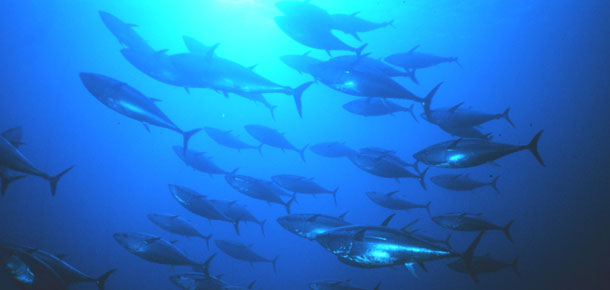Knauss legislative fellowships in Congress help build careers — and they're fun and educational. See our video and fact sheet for details.
NMFS-Sea Grant Joint Fellowship Program

Applications due on January 23, 2025. See lists of current and past graduate fellows supported by Maryland Sea Grant. |
In 1999, NOAA National Sea Grant Office and NOAA Fisheries established a graduate fellowship program in two specialized areas.
- Population and Ecosystem Dynamics: For Ph.D. students interested in the population and ecosystem dynamics of living marine resources and the development and implementation of quantitative methods for assessing their status. Up to three years of funding.
- Marine Resource Economics: For Ph.D. students interested in marine resource economics, concentrating on the conservation and management of living marine resources. Up to three years of funding.
At least four PED and one MRE fellowships are expected to be awarded. Start date for both fellowships is August 1 and the fellowship lasts for up to three years.
The main goals of the program are to:
- encourage qualified applicants to pursue careers in population and ecosystem dynamics related to living marine resources;
- encourage qualified applicants to pursue careers in marine resource economics;
- increase available expertise related to quantitative ecology for systems of living marine resources;
- increase available expertise related to the economic analysis of living marine resource conservation and management decisions;
- foster closer relationships between academic scientists and NMFS; and
- provide real-world experience to graduate students and accelerate their career development;
- support graduate students from diverse backgrounds with an interest in population dynamics or marine resource economics.
To help achieve these goals, each fellow will be required to work closely with an expert (mentor) from NMFS who may provide data for the fellow's thesis, serve on the fellow's committee, and/or host an annual summer internship at the participating NMFS facility. Mentors will be from participating NMFS Science Centers or offices.
Eligibility
Population and ecosystem dynamics and economics fellowships are available to admitted Ph.D. students enrolled in a U.S. university or college. Students must be U.S. citizens. Foreign Nationals are not eligible. See Federal Funding Opportunity for additional details.
Funding
The award for each fellowship, contingent upon the availability of federal funds, will be a cooperative agreement of no more than $66,700 in federal funds (plus 20% matching funds). The award may cover stipend (salary), tuition, fees, equipment, supplies, and travel necessary to carry out the proposed thesis research and to attend the annual fellows meeting.
How to Apply
Applications for fellowships are due via the Maryland Sea Grant's eSeaGrant proposal portal.
Step 1: You must contact Maryland Sea Grant well in advance of the fellowship deadline to gain access to the eSeaGrant portal for submission. Once notified, we will allow you to register your account and prepare your application. Visit https://eseagrant.mdsg.umd.edu, click "Add Fellowship Application" under the appropriate fellowship request for proposals call to navigate the system and create your fellowship proposal. The PI who registers should be the faculty advisor. The student should be a Co-PI, added as a 'collaborator' to the proposal in eSeaGrant. Both advisor and student must have accounts in eSeaGrant.
Step 2: You must upload all pieces of your application to the eSeaGrant proposal portal. All applications must adhere to the Federal Funding Opportunity guidelines, which include:
Project Summary/Abstract Attachment Using 4,000 characters or less, the Project Abstract should provide an overview of the application.
Project proposal narrative (Single file upload)
- Title page (one page maximum)
- Project Proposal (five pages plus references and figures)
- Education and career goal statement from the student (must not exceed two
pages single spaced) - Curriculum vitae of student, faculty advisor, and NOAA NMFS mentor (two pages max each)
- Summary of academic training in quantitative methods (one page max)
- Clear, scanned copies of undergraduate and graduate student transcripts (official or unofficial are both acceptable)
Letters of recommendation - A minimum of two signed letters of recommendation (two pages max each)
NEPA form - Abbreviated Environmental Compliance Questionnaire on the Inside Sea Grant website
Data management plan - (two pages max)
Sea Grant 90-4 Form (OMB Control No. 0648-0362) SF424 R&R Budget Form - A completed Sea Grant 90-4 form should be completed for each project year, as well as a total budget for the entire project duration (i.e., Year 1, Year 2, Year 3, and Years 1-3). (Note that a revision of the federal opportunity in January eliminated the 90-4 form requirement. Just use the R&R budget form).
Budget Narrative - Develop a yearly budget following the SF424 R&R categories. Include justification for each year of the project and explain budget items in sufficient detail. Please seek us out for guidance on this.
Demographic Question - Complete the optional NOAA demographics form for the student.
PI Information - CV of the PI of record, Current and Pending of the PI of record
We will then assemble the components for submission by our sponsored programs office through Grants.gov.
Please see the Announcement of Federal Funding Opportunity for more details on the format and content for the application: NOAA-OAR-SG-2025-29114.
Maryland Sea Grant Contact
Dr. Michael Allen, Associate Director for Research and Administration
Maryland Sea Grant College
5825 University Research Ct, Suite 1350
College Park, Maryland 20740
phone (301) 405-7500
mallen@mdsg.umd.edu
For More Information
For more details about the fellowships, visit the NOAA Fisheries/Sea Grant Fellowship website.
See the NOAA Fisheries/Sea Grant Fellowship Flyer.
Photograph, National Oceanic and Atmospheric Administration



